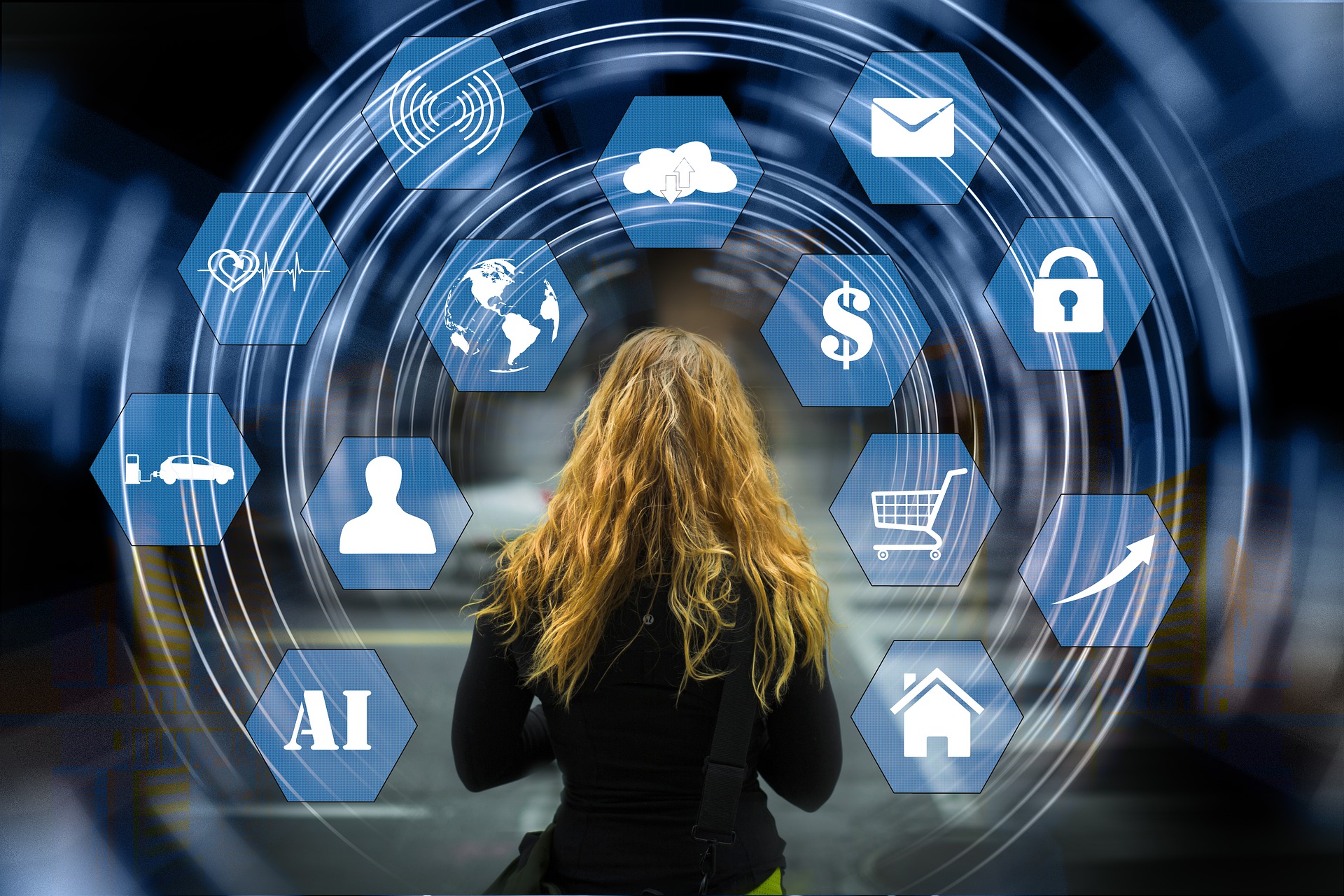When the word AI comes up, it’s only natural to think of ChatGPT online or other popular AI chatbots. While that association is valid, it’s just the tip of the iceberg. It’s equally important to delve into the inner workings of AI and understand its effects on us. In this AI 101 article, we’ll explore the basics of artificial intelligence, its uses, and its growing influence on our lives. While we’re at it, we’ll also define some terms and concepts related to AI.
What is Artificial Intelligence?
Artificial Intelligence, or AI, is a common term in today’s modern world, and understandably so. It’s used almost everywhere, from online shopping to advertising and cybersecurity. However, many people still don’t understand what AI is and how it affects us.
Believe it or not, AI has been a concept since the 1950s wherein it was defined as the machine’s ability to carry out tasks that would typically require human intelligence. In other words, AI can display human-like capabilities such as reasoning, strategizing, problem-solving, learning, and creativity.
How Does AI Work?
Essentially, AI tries to copy how humans think and solve problems using algorithms. These special programs mainly provide instructions to help the computers provide solutions and finish tasks, much like how humans do. By mimicking human skills, AI aims to reach comparable levels of effectiveness and productivity in different areas.
With all the excitement surrounding AI, companies are rushing to show off how their products and services utilize it. But sometimes, when they talk about AI, what they really mean is Machine Learning.
Now, when it comes to the AI vs. machine learning debacle, note that AI includes all methods for creating intelligent systems, while machine learning focuses on algorithms that help computers learn from data and make decisions.
Types of Artificial Intelligence
Artificial Intelligence consists of various types and methods, each having distinct features and capabilities. These AI categories can be characterized based on their purpose, functionality, level of autonomy, and application areas. Below, we explore some common types of AI:
Narrow AI (Weak AI)
Narrow AI, also known as Weak AI, is designed to perform specific tasks within a limited area. Simply put, these AI systems cannot generalize beyond their designated functions. Examples of Narrow AI include virtual assistants like Siri and Alexa, chatbots, and recommendation systems.
General AI (Strong AI)
General AI, also referred to as Strong AI or Artificial General Intelligence (AGI), represents a hypothetical form of AI that exhibits human-like intelligence across a wide range of cognitive tasks. Unlike Narrow AI, which focuses on specific tasks, General AI can understand, learn, and apply knowledge in diverse contexts, akin to human intelligence.
Machine Learning
A subset of AI, Machine Learning (ML) concentrates on creating algorithms with the ability to learn from data without being explicitly programmed. Through algorithms, machines can analyze patterns from data, enabling them to improve their performance over time. Common approaches within Machine Learning include supervised learning, unsupervised learning, and reinforcement learning.
Deep Learning
Deep Learning is a specialized branch of Machine Learning where computers learn by analyzing vast amounts of data. Using deep neural networks—computer systems inspired by the human brain with many layers—Deep Learning can tackle complex tasks like recognizing images, understanding language, and processing speech. Convolutional Neural Networks (CNNs) and Recurrent Neural Networks (RNNs) are popular models within Deep Learning.
Reinforcement Learning
Reinforcement Learning is a type of Machine Learning where an AI-driven system (or agent) learns to make decisions by interacting with an environment and receiving feedback in the form of rewards or penalties. The agent aims to maximize cumulative rewards over time by learning optimal strategies through trial and error. Reinforcement Learning is primarily used in various fields, such as robotics, game-playing, and autonomous systems.
Symbolic AI
Symbolic AI relies on symbolic representation and manipulation of knowledge using logic and rules. Symbolic AI systems operate based on predefined rules and symbols, making logical inferences and deductions to solve problems. Expert systems and knowledge-based systems are examples of Symbolic AI.
Advantages and Disadvantages of AI
In this section, we’ll shed light on AI’s impressive capabilities and the challenges it presents.
Here are the advantages of AI:
- AI can automate repetitive tasks.
- AI systems can process vast amounts of data quickly and accurately, improving efficiency and productivity.
- AI systems can operate round-the-clock without fatigue.
- AI enables personalized experiences by analyzing user data and preferences.
- AI can analyze historical data to make predictions about future trends, helping businesses make informed decisions.
- AI-powered systems can improve safety in various domains, such as autonomous vehicles, by detecting and preventing potential risks.
- AI can lower operational costs by streamlining processes, reducing errors, and optimizing resource allocation.
- AI enables the development of new products, services, and solutions that were previously unattainable.
On the other hand, here are the downsides of AI:
- AI automation may lead to job displacement as machines replace human workers in certain tasks and industries.
- AI algorithms can inherit biases from the data they are trained on. This leads to discriminatory outcomes, particularly in decision-making processes.
- AI systems often require access to large amounts of personal data, raising concerns about privacy and data security.
- Overdependence on AI systems can lead to a loss of critical thinking skills and reliance on technology for decision-making.
- AI raises ethical concerns, such as the use of autonomous weapons and the impact on societal values and norms.
- AI systems may struggle with tasks that require common sense reasoning or understanding of context.
- Increased reliance on AI-driven interactions may lead to decreased human-to-human interaction.
Everyday Examples of Artificial Intelligence You Should Know
You might think AI is only for big tech companies and doesn’t affect your daily life. But in truth, AI is all around us.
Here are eight ways AI is already part of our everyday lives.
Recommendation Systems
Online platforms such as Netflix, Amazon, and Spotify leverage AI-powered recommendation systems to analyze user preferences, behavior, and interactions to suggest personalized content, products, and playlists.
Navigation Apps
Navigation apps like Google Maps and Waze utilize AI algorithms to analyze real-time traffic data, historical patterns, and user inputs to optimize route planning and provide accurate navigation instructions. These AI-powered navigation apps help users navigate efficiently, avoid traffic congestion, and reach their destinations faster.
Predictive Text and Autocorrect
AI algorithms integrated into keyboards and messaging apps use predictive text and autocorrect features to suggest words and phrases based on context, language patterns, and user behavior. These AI-powered features enhance typing speed, accuracy, and overall user experience on smartphones and other devices.
Email Filtering and Spam Detection
Email services use AI algorithms to filter incoming emails, identify spam, and prioritize important messages based on content, sender reputation, and user preferences. AI-powered email filtering systems help users manage their inboxes effectively and reduce the influx of unwanted or irrelevant emails.
Image and Speech Recognition
AI technologies such as facial recognition and speech recognition are integrated into various applications and devices, including smartphones, cameras, and security systems. These AI-powered capabilities enable tasks such as unlocking devices, tagging photos, transcribing speech, and controlling devices through voice commands.
Smart Home Devices
Smart home devices like smart thermostats, security cameras, and lighting systems leverage AI technologies to learn user preferences, adjust settings automatically, and optimize energy consumption. AI-powered smart home devices enhance convenience, comfort, and energy efficiency in residential environments.
Customer Service Chatbots
Many businesses utilize AI-powered chatbots to provide instant customer support and assistance on their websites, social media platforms, and messaging apps. These chatbots use natural language processing (NLP) and machine learning algorithms to understand and respond to customer queries, resolve issues, and streamline customer service operations.
Shopping Experiences
E-commerce platforms employ AI-powered recommendation engines and personalization algorithms to analyze user browsing behavior, purchase history, and preferences to recommend relevant products, offer personalized discounts, and create customized shopping experiences. AI-driven personalization enhances user engagement and increases conversion rates in online retail.
4 AI Services Available To Use
Today, users can easily access a wide range of AI-powered services in different fields. Here are four examples showcasing the diversity and usefulness of AI services available for use:
ChatGPT
ChatGPT is an AI-powered conversational agent that excels in generating human-like text responses. Leveraging cutting-edge natural language processing (NLP) algorithms, ChatGPT can engage in meaningful conversations, provide assistance, and even generate creative content across a wide range of applications, from customer support chatbots to virtual assistants.
Google Cloud Vision API
Google Cloud Vision API lets developers integrate image recognition and analysis capabilities into their applications. Powered by machine learning algorithms, this service can identify objects, landmarks, and text within images, extract relevant information, and classify images based on content. It is invaluable for tasks such as image search, content moderation, and automated metadata generation.
Amazon Comprehend
Amazon Comprehend is a natural language processing service offered by Amazon Web Services (AWS) that enables developers to analyze and extract insights from text data. Using advanced machine learning techniques, Amazon Comprehend can perform tasks such as sentiment analysis, entity recognition, and key phrase extraction, empowering businesses to gain valuable insights from large volumes of textual data, including customer reviews, social media posts, and documents.
IBM Watson Assistant
IBM Watson Assistant is an AI-powered virtual assistant platform that enables organizations to build and deploy conversational agents for customer service, support, and other applications. Leveraging AI technologies such as natural language understanding (NLU) and machine learning, Watson Assistant can understand user queries, provide accurate responses, and escalate complex issues to human agents when necessary, enhancing customer engagement and satisfaction.
Conclusion
In a nutshell, our AI 101 guide offers a glimpse into the world of artificial intelligence, revealing its widespread influence beyond just chatbots like ChatGPT. Exploring AI basics and its real-world applications shows how it shapes various aspects of daily life. Let’s explore the capabilities of artificial intelligence, all while remaining vigilant in addressing its challenges to ensure a future where technology enhances our lives for the better.






